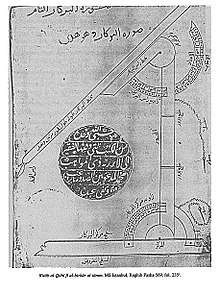Siraj ud-Din Muhammad ibn Abd ur-Rashid Sajawandi
Sirāj ud-Dīn Muhammad ibn Muhammad ibn 'Abd ur-Rashīd Sajāwandī (Persian: محمد ابن محمد ابن عبدالرشید سجاوندی) also known as Abū Tāhir Muhammad al-Sajāwandī al-Hanafī (Arabic: ابی طاهر محمد السجاوندي الحنفي) and the honorific Sirāj ud-Dīn (سراج الدین, "lamp of the faith") (died c. 1203 CE or 600 AH)[1] was a 12th-century Hanafi scholar of Islamic inheritance jurisprudence, mathematics[2] astrology and geography.[3] He is primarily known for his work Kitāb al-Farāʼiḍ al-Sirājīyah (Arabic:کتاب الفرائض السراجیه), commonly known simply as "the Sirājīyah", which is a principal work on Hanafi inheritance law.[2][4] The work was translated into English by Sir William Jones in 1792 for subsequent use in the courts of British India.[5][4][6] He was the grand-nephew of qari Muhammad ibn Tayfour Sajawandi. He lies buried in the Ziārat-e Hazrat-o 'Āshiqān wa Ārifān in Sajawand.[7]
Abū Tāhir Muhammad Sajāwandī | |
|---|---|
| Born | 12th century CE |
| Died | 1203 CE |
| Academic background | |
| Influences | Muhammad ibn Musa al-Khwarizmi, Al Biruni |
| Academic work | |
| Era | Islamic Golden Age |
| Main interests | Islamic inheritance jurisprudence, mathematics, astrology, geography, theology |
| Notable works | The Sirajiyya, The Analogy for the Calculations, Treatise on Algebra |
| Influenced | Ali ibn Mohammed al-Jurjani, Shahab ud-Din Ahmad ibn Mahmud al-Siwasi, Burhan ud-Din Haidar ibn Muhammad al-Hirwi, Shams ud-Din ibn Hamza al-Fanari, Abdul Karim ibn Muhammad al-Hamdani |
Name
His full name is Sirāj ud-Dīn Abū Tāhir Muḥammad Ibn Muhammad ibn 'Abd ur-Rashīd ibn Tayfoūr Sajāwandī (Persian: سراج الدین محمد سجاوندی)[1]. His nasab, Ibn Muhammad ibn 'Abd ur-Rashīd ibn Tayfoūr refers to him being the "son of Muhammad son of 'Abd ur-Rashīd son of Tayfour"). Sajāwandī is his nisbah meaning "from Sajawand". He is also known by the teknonym Abū Tāhir meaning "father of Tahir".
Works
- Kitāb al-Farāʼiẓ al-Sirājīyah (The Sirajite Book of Inhertiance laws, کتاب الفرائض السراجیه) a.k.a. al-Sirājīyah ("The Sirajite")
- al-Tajnīs Fī al-Hasāb (The Analogy for the Calculations , کتاب التجنیس فی الحساب)
- Resālat Fī al-Jabr wa al-Muqābilah (Treatise on Algebra , رسالة فی الجبر و المقابله)
References
- الزركلي, خير الدين. الأعلام - ج 7 : محمد بن قاسم - نافع بن الحارث (in Arabic). IslamKotob.
- "Al Sirajiyyah: Or the Mahommedan Law of Inheritance". 1890. Retrieved 2018-05-06.
- "Islamic astronomy and geography | Sci-napse | Academic search engine for paper". Scinapse. Retrieved 2018-12-12.
- Young, M. J. L.; Latham, J. D.; Serjeant, R. B. (2006-11-02). Religion, Learning and Science in the 'Abbasid Period. Cambridge University Press. ISBN 9780521028875.
- Kozlowski, Gregory C. (2008-10-30). Muslim Endowments and Society in British India. Cambridge University Press. ISBN 9780521088671.
- Zaman, Muhammad Qasim (2010-12-16). The Ulama in Contemporary Islam: Custodians of Change. Princeton University Press. ISBN 9781400837519.
- "د لوګر تاريخي، فرهنګي محلات". loyghar.bloguna.tolafghan.com. Retrieved 2018-12-10.
